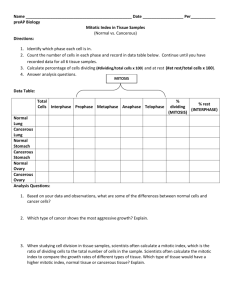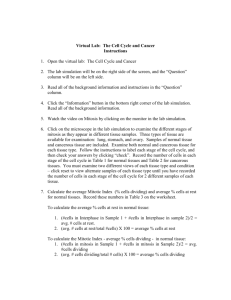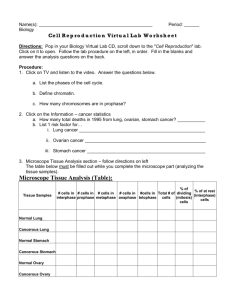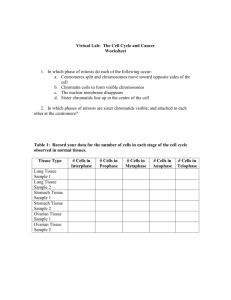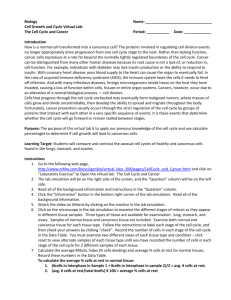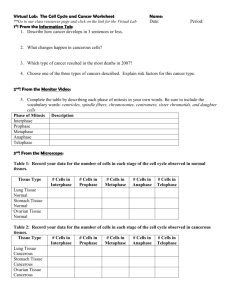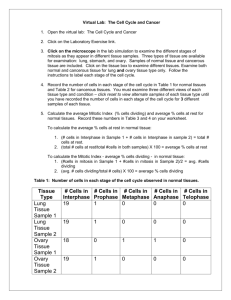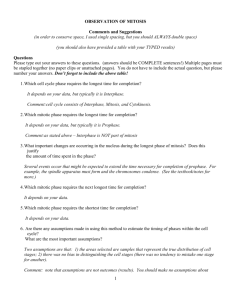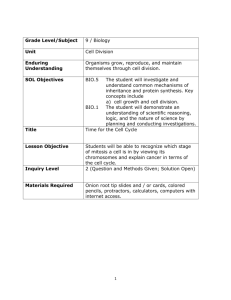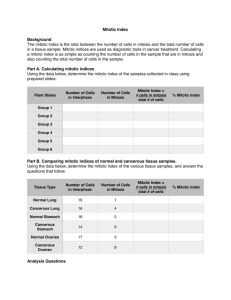Cellular Reproduction (Mitosis) Virtual Lab Instructions *NOTE: The
advertisement
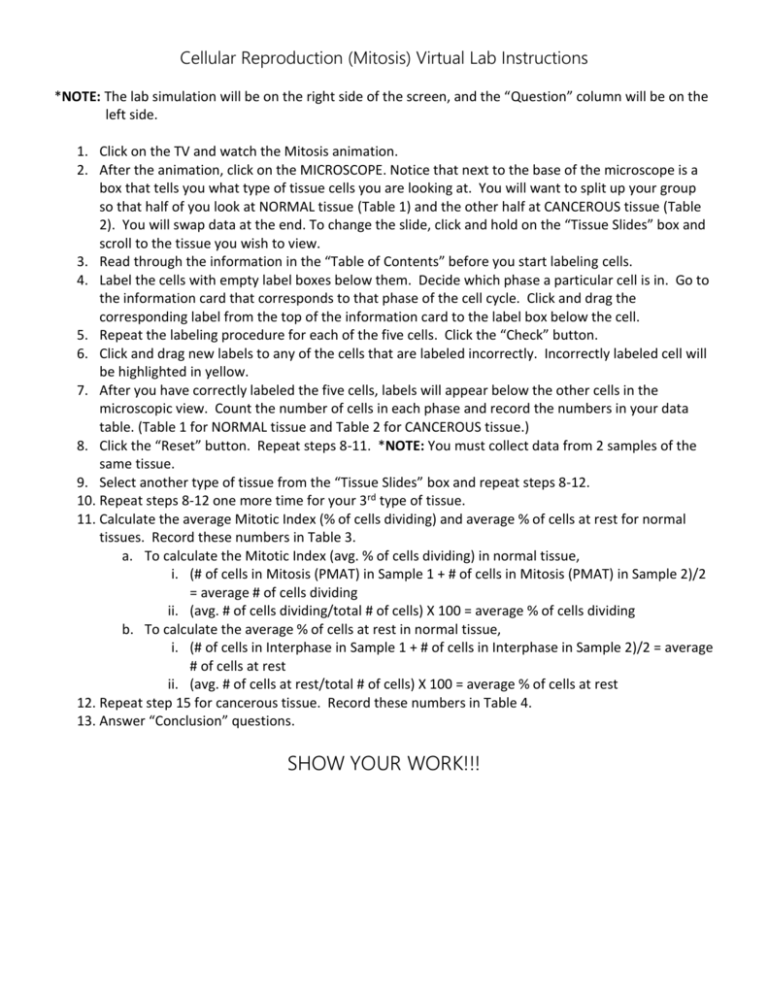
Cellular Reproduction (Mitosis) Virtual Lab Instructions *NOTE: The lab simulation will be on the right side of the screen, and the “Question” column will be on the left side. 1. Click on the TV and watch the Mitosis animation. 2. After the animation, click on the MICROSCOPE. Notice that next to the base of the microscope is a box that tells you what type of tissue cells you are looking at. You will want to split up your group so that half of you look at NORMAL tissue (Table 1) and the other half at CANCEROUS tissue (Table 2). You will swap data at the end. To change the slide, click and hold on the “Tissue Slides” box and scroll to the tissue you wish to view. 3. Read through the information in the “Table of Contents” before you start labeling cells. 4. Label the cells with empty label boxes below them. Decide which phase a particular cell is in. Go to the information card that corresponds to that phase of the cell cycle. Click and drag the corresponding label from the top of the information card to the label box below the cell. 5. Repeat the labeling procedure for each of the five cells. Click the “Check” button. 6. Click and drag new labels to any of the cells that are labeled incorrectly. Incorrectly labeled cell will be highlighted in yellow. 7. After you have correctly labeled the five cells, labels will appear below the other cells in the microscopic view. Count the number of cells in each phase and record the numbers in your data table. (Table 1 for NORMAL tissue and Table 2 for CANCEROUS tissue.) 8. Click the “Reset” button. Repeat steps 8-11. *NOTE: You must collect data from 2 samples of the same tissue. 9. Select another type of tissue from the “Tissue Slides” box and repeat steps 8-12. 10. Repeat steps 8-12 one more time for your 3rd type of tissue. 11. Calculate the average Mitotic Index (% of cells dividing) and average % of cells at rest for normal tissues. Record these numbers in Table 3. a. To calculate the Mitotic Index (avg. % of cells dividing) in normal tissue, i. (# of cells in Mitosis (PMAT) in Sample 1 + # of cells in Mitosis (PMAT) in Sample 2)/2 = average # of cells dividing ii. (avg. # of cells dividing/total # of cells) X 100 = average % of cells dividing b. To calculate the average % of cells at rest in normal tissue, i. (# of cells in Interphase in Sample 1 + # of cells in Interphase in Sample 2)/2 = average # of cells at rest ii. (avg. # of cells at rest/total # of cells) X 100 = average % of cells at rest 12. Repeat step 15 for cancerous tissue. Record these numbers in Table 4. 13. Answer “Conclusion” questions. SHOW YOUR WORK!!! Name: _______________________________________ Date: _______________________ Period: ________ Cellular Reproduction (Mitosis) Virtual Lab 1. Using the information from the Mitosis animation and the Table of Contents, in which phase of mitosis do each of the following occur: a. Centromeres split and chromosomes move toward opposite sides of the cell _________________ b. Chromatin coils to form visible chromosomes _____________________ c. The nuclear membrane disappears _____________________ d. Sister chromatids line up in the center of the cell ______________________ 2. In which phases of mitosis are sister chromatids visible and attached to each other at the centromere? Table 1: Normal Tissues # of cells in Tissue Type Interphase Lung Tissue Sample 1 Lung Tissue Sample 2 Stomach Tissue Sample 1 Stomach Tissue Sample 2 Ovarian Tissue Sample 1 Ovarian Tissue Sample 2 Table 2: Cancerous Tissues # of cells in Tissue Type Interphase Lung Tissue Sample 1 Lung Tissue Sample 2 Stomach Tissue Sample 1 Stomach Tissue Sample 2 Ovarian Tissue Sample 1 Ovarian Tissue Sample 2 # of cells in Prophase # of cells in Metaphase # of cells in Anaphase # of cells in Telophase # of cells in Prophase # of cells in Metaphase # of cells in Anaphase # of cells in Telophase Table 3: Normal Tissue – Mitotic Index (avg. % of cells dividing) & Avg. % of cells at rest Tissue Type Mitotic Index Avg. % of cells at rest Lung – normal Stomach – normal Ovarian – normal Table 4: Cancerous Tissue – Mitotic Index (avg. % of cells dividing) & Avg. % of cells at rest Tissue Type Mitotic Index Avg. % of cells at rest Lung – cancerous Stomach – cancerous Ovarian – cancerous Conclusion Questions 1. What does your data indicate about the rate of cell division in cancerous tissue compared to the rate of cell division in normal tissue? What data tables did you use to answer this question? 2. Which type of cancer is the fastest growing? Justify your answer with information from Table 4. 3. With what you have observed in this lab, if you were to compare tissue samples from normal breast tissue and cancerous breast tissue, would you expect to see a difference in the rate of cell division in the cancerous tissue compared to the normal tissue? Explain your answer. 4. Consider the % of dividing cells in normal lung, normal stomach, and normal ovarian tissue. Why do you think there are more cells dividing in the stomach and ovary than in the lung?
